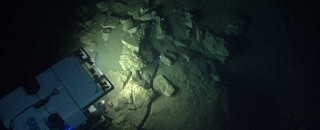The hard rock mines of Nevada County, CA, probably the most gold over all came from hard rock mines in Nevada County Ca. These mines were pretty much started after the '49ers.
If you have a lot of money, you can get gold by mining. The use of digging machines, drilling machines, and loading machines costs. Then there is the cost of claims, employees, lawyers, permits, etc which preclude the lightly financed. Hard rock mining is pretty well left to those who are well-healed.
One can prospect in hopes of finding an outcropping of gold and quartz, but again, it's pretty much the rare bird who comes across such a thing. If you do, start buying an occasional lottery ticket. It is surmised by most academics that the entire west (California, Nevada, Arizona, and Oregon) has been scanned by prospectors over the course of the last couple hundred years.
The aspect of prospecting that gets the most attention these days is the effort put out by placer prospectors. Yes, big companies prospect, but placer prospecting has become a great hobby for outdoor enthusiast looking for a pastime that can offer some exercise and the possibility of fortune. In the 1980's there was a boom in amateur prospecting for color when the price of gold shot up, and with Covid-19 in 2020, the boom continues.
Whereas in 1849 a prospector could walk a stream and on a sunny day get a flash from a gold nugget, it isn't quite that easy today. Oh, there may be a nugget like that found (however unlikely), but most people are searching for smaller flakes.
Though geologists have learned what type of rock formations typically produce the most gold. Amateurs for the most part search waterways (or old waterways no longer carrying water) looking for black sand. Black sands are used by miners and prospectors to indicate the presence of a placer formation. Placer mining activities produce a concentrate that is composed mostly of black sand. Black sand concentrates often contain additional valuables, other than precious metals (read to mean gemstones).
Profitable mining areas are very rare. But metal can be found in almost all waterways - but it appears as such small particulates that it is of little value. However, small gold particulates are of interest to the amateur prospector with gold nearing $2000 an ounce.
After taking many core samples, a mining company may decide to break ground. If the gold is near the surface, an open pit mining operation may be started. One more issue related to open pit mining involves the extraction of precious metals from copper mines. Gold, silver, and platinum are almost always associated with copper veins. Though copper is the goal of the open-pit operation, the gold and silver separated from the ground ore is frequently enough to pay for the operation. Gives you pause for thought, right?
Lode mining involves cracking rock and digging tunnels along the veins. There is usually a main tunnel and then side tunnels breaking off as more veins are discovered. Mercury fulminate, lead azide or PETN (or penthrite, or more properly Penta Erythritol Tetra Nitrate ) are good examples of primary explosives used in the mining industry. They can be found in blasting caps and detonators. Both open pit and lode mining utilize explosives.
Placer deposits are panned. Panning involves agitating water and material, we hope, with gold flake in it. Usually when there is nothing left in the pan but black sand, the prospector can see the yellow of gold. At that step he gently washes over the black sand until gold is revealed.
Panning is back breaking work - one can appreciate the difficulty in making a living during the 19th century by panning. That scruffy old prospector with a mule or burro was a tough hombre.
I hope this overview of types of mining gives you a good feel for the opportunity that can exist from mining. Here is a metaphor that I think is appropriate. When in New York City, a person can appreciate the busyness of the place by walking down Broadway, but peering from the Empire State Building is a whole different vision.
References:
1. How Gold Works, by William Harri
2. Wikipedia
3. The Explosives Used in Mining, by Phillipe Dozolme
Unsplash.com - Open pit operation












